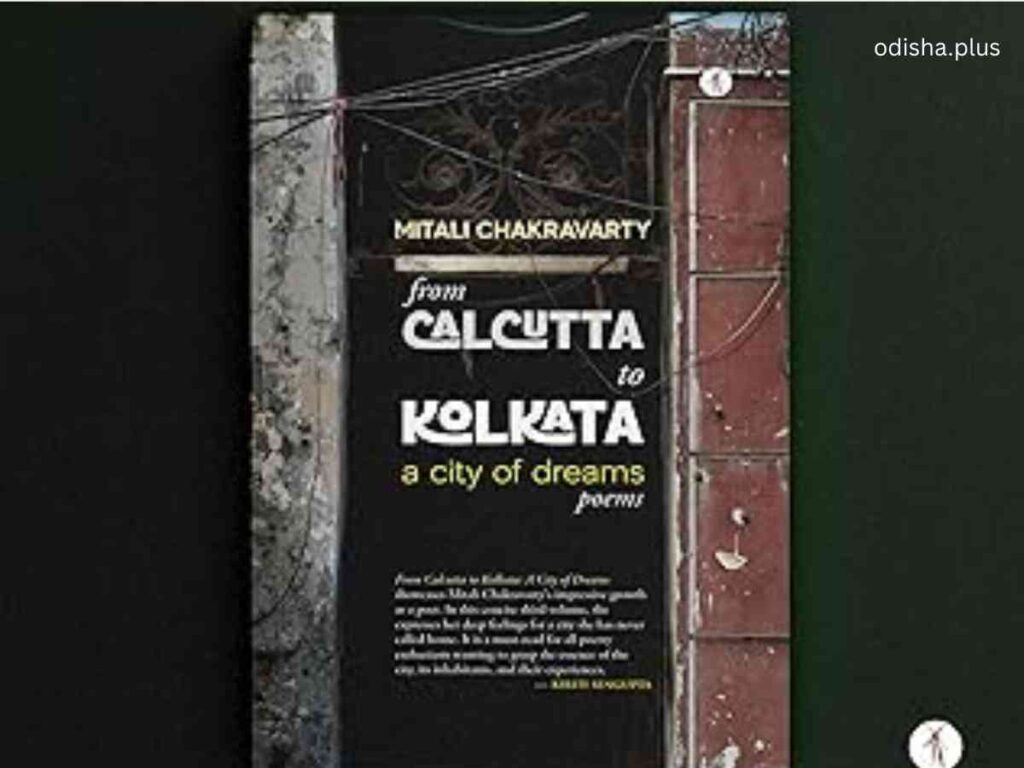From Calcutta to Kolkata is more than a poetic journey—it’s a layered exploration of a city’s evolving identity. Through vivid imagery and introspective verses, the collection captures Kolkata’s transformation across time, culture, and memory
Snehaprava Das

A city is not inert, or lifeless. It is a living entity pulsating with meanings and ideas and its aura. It is where millions of dreams are sketched, and millions of stories are painted.
Understanding the spirit of a city is like interpreting an array of emotions and ideas that form, convene, grow, and prevail. To explore a city through its gradual and recurrent phases of evolution is like deciphering an archetypal pattern that manifests itself in the persona of a city, its predispositions, its culture, and its changing urban dynamics. The collection of poems From Calcutta to Kolkata, which the poet describes as a journey of self-discovery chronicles not just the poet’s experiences through her intermittent stays there, but portrays a city the poet carries inside her persona in its varied shades.
Viewed from this perspective, From Calcutta to Kolkata is not just a literary endeavor to humanize a city but to discover the integral elements that map out the evolution of the city through the poet’s journey across the memory space, a keen analysis of the cultural, social, spiritual hieroglyphics embedded in the subconscious of both.
It is a many-layered text that could be one plane understood as a record of the poet’s sentimental attachment to the city depicted through a vivid portrayal of her relationships with her close relatives like her maternal aunt and grandmother; on another plane, it could be described as the city’s search for identity through the changing times; studied on a different level it could be seen as a bridge connecting the mood of a city under the process of transformation and the poet’s emotional response to it.
The transition of the city of Calcutta to Kolkata is an eventful ‘journey in time.’ For the poet, it is the journey of a ‘wanderer moving through the mind-space of time and place,’ savoring the flavor of the past, present, and future.’ But the journey of the city, through geography as well as history, begins at a modest inception point about three centuries ago when three villages were merged together to set up a city.
And yet it all started with three,
Three villages woven
More than three hundred years ago (Ooh Calcutta!)
Calcutta which sheltered people from varying cults and ideologies, has emerged as a city of heterogeneous demography and of a syncretic culture. It is a city that ‘homed diverse people—Bengalis, Marwaris, Dutch, Portuguese, British and many other with multiple belief-systems.’
The poem ‘Dum Dum’ sketches Calcutta as a city of crisscrossing streets and lanes and of houses structured higgledy-piggledy, where rich and poor grew symbiotically. Narrow dusty lanes wind now and then by open drains to reach beyond the outskirts…..people lose themselves like waterdrops in the Bay of Bengal. (DumDum)
It is a city of a bustling college street, busy coffee houses, and pavements full of booksellers, where there are broken tiles under the feet and cracked pipes spewing water on the roads. This is a city that embraces the poor and rich with equal spirit. The divides stick, but they still gather in coffee houses that carry the memories of Tagore, Subash Bose, Manna Dey, Satyajit Ray, and MrinalSen, sharing the lingering and refreshing aroma over nostalgia.
All along the journey, the poet’s mind is haunted by the new Kolkata’s past.
I delve deep into my soul like a magician
I pull out ghosts, some are from Calcutta (Ghosts)
**
Sometimes they reflect streams of
My past, my present, and the future that I see…
The shadows of the past, the memory of the lived experiences that come crowding to the poet’s mind in her nostalgic moments come alive in her inner conscious, where the flux, the flowing past, present, and future become a single moment of permanence delineating a simultaneity of experience.
Juxtaposed with the joy of an old, aristocratic city transitioning into a modern metropolis, the largest urban agglomeration in eastern India, there is a nagging doubt that reflects itself in the poet’s question, Why Does Kolkata Cry? The gradual transformation of the city discernible in the auto rickshaws replacing their hand-pulled counterparts dusts turning stickier, and the city growing Kintsugied with love sparks a new hope ‘built with dreams’ (City of Joy). But in this city of dreams people still live toiling to make ends, meet despite load-shedding, contamination, disease, traffic jams, and more… (Calcasians).
The mood of skepticism that remains dormant in the poet’s subconscious most of the time, surfaces in vulnerable moments and finds expression in lines like:
The city is layered with opposites and in-betweens.
And all those in-betweens –
Some try to reach for the artificial skies,
Others are just happy to smile; (Monalisa?)
She finds it amazing that people here find happiness amidst sweat, michhils, joblessness, and hunger. Perhaps this is where the magic of the city rests… a magic rhythm that makes its dwellers feel alive.
‘We were told and believed,’ the poet writes in her introduction to the collection, ‘Calcutta was a city where people were taught to treat women with respect. … Women’s emancipation was woven into my being by the heritage and culture that nurtured me.’ Hence we come across poems here that eulogize the role of a woman in society, her sacrifice and struggle with her self-esteem, and her bold denial to subscribe to a gender-biased system that denigrates a woman’s efforts at self-actualization and her strong protest against the atrocities perpetrated on their community.
Poems like Monobinanarrate a woman’s unconditional sacrifice for, and her dedicated support to her family. Monobinas here could prove their worth without fighting war alongside their male partners, without being goddesses to fight demons.
Monobina cycles four hours through the
Broken streets of Calcutta to work, earn the fee
For her child’s education. (Monobina)
Monobinas here are not lauded for all the pains and hardships they go through to survive but ironically are given a red carpet welcome by the red mud that rolls out on the street as a lungi-ed man bathes in the gush of a tubewell.
The red mud rolls out a carpet for Monobina… (Vignettes)
The feminist undertone is obvious in poems like ‘The City Whispers’ that celebrates Abhaya the fearless and ‘Oborodh Awake’ that rings with a voice of protest against the sacrilege women suffer in the hands of the self-proclaimed moralists, and the way they fall prey to the raw passion of persons who are believed to be the vanguards of the social security.
Army men, Policemen—
Men who will protect women
Violate, watch, and rape
A twenty-one-year-old;
The poem ‘Self’ celebrates and glorifies the identity of a woman
I admire the performance of
‘Phenomenally Women.’
I celebrate my own womanhood,
I identify. I emphasize. (Self)
The lines with which the poem begins, for a brief moment, bring into mind the famous lines from Shakespeare’s Antony and Cleopatra where Cleopatra declares I am air and fire/ My other elements I give to baser life, and the last lines echo a Whitmanian undertone I am the poet of the body and I am the poet of the soul/ I will make the poems of my body where Whitman proclaims the need of the physical pleasure to enrich the Self. What could have been a better way to elevate a woman’s status in a male-construct world?
From Calcutta to Kolkata does not stop at celebrating woman, it sings of humanity, its resilience, its instinct to survive.
Now renamed Kolkata by some who believe
That humanity grew out of the soil like trees
Calcutta still exists under the broken tiles of this street
Though Presidency College’s privatized College Street
With the Coffee House still survives. (College Street)
There are moments in the poems that take the reader back to the days of ancient Bengal’s opulent literary heritage, poems like Jorasanko I and II and On the Way to Jorasanko are moving reminiscences of the growth of R.N Tagore as a poet.
here stands the bust of the greatest mind
a mind that spun words to shape an ideal world,
a world laced with love, kindness, compassion
a soul that bled, wrote, rallied for one Bengal. (Jorasanko II). No better or sincere tribute could have been offered to one of the greatest poets of the world. If the poems sing the glory of Calcutta’s literary ancestry, they also laud the new writing of Kolkata the modern city of dreams. The literary journey never stops:
In Kolkata, they do not pause but weave songs
Of kintsugied lives that touch my soul to soar. (Words)
At such moments the reader is left amazed at the way the text coalesces the maverick mindscape of the poet and the urban landscape of Kolkata that has risen from a glorious ancientness to one of glamorous modernity, a city that owes its genesis to three villages that existed three centuries ago… a city that never fails to impress and influence her.
It is not just an interesting literary piece that registers the reshaping of the city’s infrastructure over the years that made Kolkata evolve but an evolution of the ideologies of a poet in a journey of self-exploration. It is a parallel journey of introspection, of mood- mood-transferring, of acceptance of the ever-changing pattern of life.
The poems could be seen as efforts to define the poet’s intimate bonding with Calcutta despite her limited exposure to the city, to understand the life that sits on its sinews, to trace out the delicate threads that weave intricate connectivity between the poet’s mood and the elements of the city through its changing socio-cultural scenario, to examine the degree of proximity between the poet and the city.
Ultimately, what dominates is a pure Love for the spirit of the city that remains unchanged through the transitioning process. Still, the subtle note of skepticism underlying the revealed joy at witnessing the city in its new garb could not be dismissed.
Displaced in time Tagore, Nazrul, Teressa / could alight at PrinsepGhat/ but would they find the world the left behind/ would they find their aspirations fulfilled? (Buddha in Kolkata)
Profound questions the poet is haunted with, questions the poet leaves unanswered, questions she flings at her readers. This one is a powerful work built around a cluster of complex issues relating to the emergence of a new Calcutta, a dream city caught in a web of many paradoxes. One can always say emulating Shakespeare, ‘What’s in a name?’ But the poet would not accept the aphorism without a question when it comes to a journey from Calcutta to Kolkata.



























